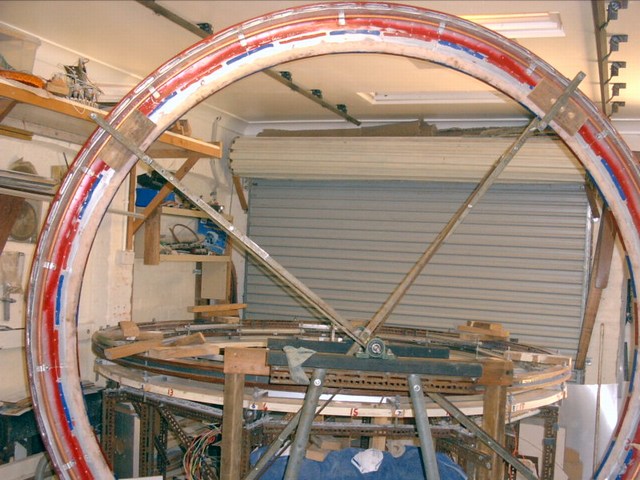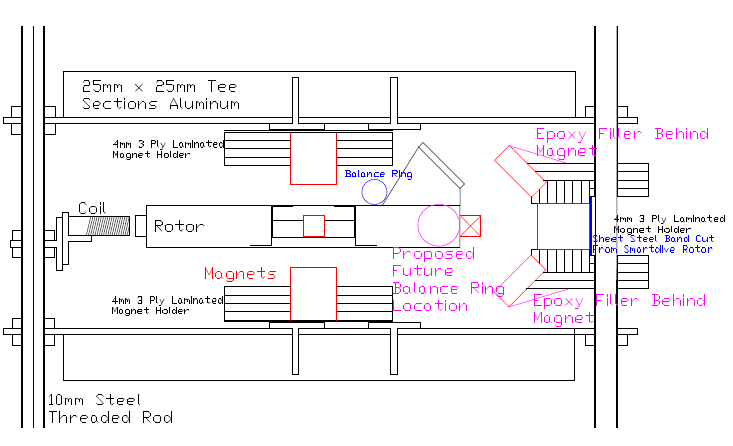

Lifting gear has been converted to a hub, bearings, and spokes to statically balance the rotor. Adding 45 grams has made the rotor reasonably well balanced. When spun it will stop in fairly random locations. There is a copper tube ring fitted, 10.9mm internal diameter with a volume about 0.66 litre.
This is for dynamic balancing. It is held in place with clips as shown, and also silicone sealant, and is located in the angle of the stiffening ring. It has a small filler plug. Mercury can be used as the balancing medium, or small bearing balls in oil. I will probably use 50gm of 3/32 brass balls (non magnetic) in 50gm of moly oil to start testing.
This is for dynamic balancing. It is held in place with clips as shown, and also silicone sealant, and is located in the angle of the stiffening ring. It has a small filler plug. Mercury can be used as the balancing medium, or small bearing balls in oil. I will probably use 50gm of 3/32 brass balls (non magnetic) in 50gm of moly oil to start testing.

Most balancing is required on machinery which has an axle or centrally located shaft. This machine uses a levitating rotor with no central or any other connection. True balance may be dependant on the uniformity of the magnetic fields in which the rotor floats. It may need much more dynamic weighting, or may be self balancing.
The rotor is 2400mm outside diameter, and weighs 28kg

A Balance Ring fitted as shown, with an internal diameter of 20mm, would have a volume of about 2.361 liters. If 90% of the volume, (2.12 liters) was filled with mercury the weight of the rotor would increase by 28.68 Kg. This could be a meaningful amount to test for any antigravitational effects thought to be associated with rotating mercury. As a purely balancing ring function, a quantity of about 250 grams would probably be sufficient.
The 12mm copper tube ring I have fitted was available at the time, and easy to work with. I now believe this is not suitable for use with mercury. I will probably use oil and lead shot for balance.
The proposed ring should be steel. There is a steel layer behind the radial magnets of
my first rotor. This helps when fitting the magnets, and also seems to increase magnetic field strength. This steel is salvaged from behind the magnets in the rotor of
the F&P Smartdrive, and is probably silicone steel, or similar, to minimize eddy currents. Fitting the steel tube in this position may have detrimental effects, but the large air gap may help. When the rotor is spinning, the mercury would be stationary within the balance ring, and therefore stationary within the magnetic fields of the magnets attached directly to the steel ring. However, the entire assembly would be rotating within the magnetic fields of the frame radial magnets. The effects may be interesting.
While the proposed location would enable an even larger diameter tube, and greater weight, there may be problems with the levitational axial magnetic fields ability to support more.
The 12mm copper tube ring I have fitted was available at the time, and easy to work with. I now believe this is not suitable for use with mercury. I will probably use oil and lead shot for balance.
The proposed ring should be steel. There is a steel layer behind the radial magnets of
my first rotor. This helps when fitting the magnets, and also seems to increase magnetic field strength. This steel is salvaged from behind the magnets in the rotor of
the F&P Smartdrive, and is probably silicone steel, or similar, to minimize eddy currents. Fitting the steel tube in this position may have detrimental effects, but the large air gap may help. When the rotor is spinning, the mercury would be stationary within the balance ring, and therefore stationary within the magnetic fields of the magnets attached directly to the steel ring. However, the entire assembly would be rotating within the magnetic fields of the frame radial magnets. The effects may be interesting.
While the proposed location would enable an even larger diameter tube, and greater weight, there may be problems with the levitational axial magnetic fields ability to support more.

